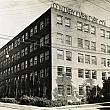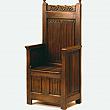Century Furniture Co. Building Description
by Rebecca Smith-Hoffman
The Century Furniture Factory is located at the corner of Ionia Avenue and Logan Street on the near southwest side of Grand Rapids in an area occupied by factories and warehouses that developed along an extensive system of rail lines adjacent at the west (the former rail line route is now occupied by the 131-expressway). This U-shaped, five-story, flat-roofed, brick building exhibits a utilitarian design typical of manufacturing plants of its time that has been minimally altered from its 1927 appearance.
The original 60’ x 145’ section of the building, constructed in 1910, was designed by Grand Rapids architect George L. Stone and built by the Appleyard & Johnson construction company. The façade of the original five-story structure extends nine bays along Logan Street, with each bay containing a pair of 8/8 wood, double-hung windows. Offices and the upholstery and shipping departments were located on the first floor, with a show room on the fifth floor. The building also featured an up-to-date automatic sprinkler system. Power was provided by a separate power house located to the south of the building.
 In 1920, Stone designed a two-story addition that extended an additional ninety feet along Ionia Avenue, forming the west arm of the U-shape; two years later, three additional floors were added. These additions contain seven bays of large multi-paned steel sash windows at the west and facing the courtyard, with three bays at the south.
In 1920, Stone designed a two-story addition that extended an additional ninety feet along Ionia Avenue, forming the west arm of the U-shape; two years later, three additional floors were added. These additions contain seven bays of large multi-paned steel sash windows at the west and facing the courtyard, with three bays at the south.
The five-story, east arm of the building, designed by Grand Rapids architect Harry L. Mead, was added in 1927. The addition is eight bays wide at the east and ten bays wide at the north. Although the windows at the east have large multi-paned steel sash, those at the north continue the pattern of the original building – pairs of 8/8 wood, double-hung windows – providing a consistency of design along the north elevation.
The interior space of the original building and its additions remains as it was when used for furniture production – open, with regularly spaced, chamfered wood columns, ceilings open to beams and joists, and wood floors, often bearing scars left by long-absent machinery. The many windows and relatively narrow width of the building allow abundant natural light to enter from the courtyard and exterior facades.

 facebook
facebook

